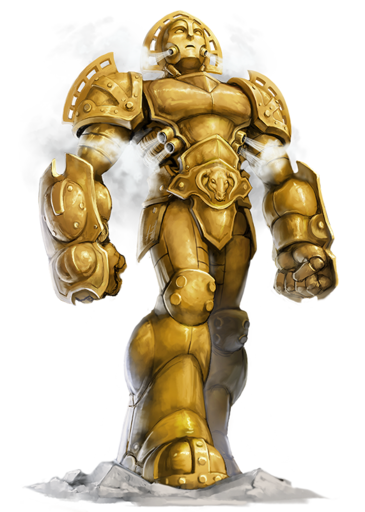
Adventures are usually about the events taking the heroes away from home. But this series explores possibilities when taking a character back home. What troubles lurk in a PC’s hometown? What manner of curse, bogeyman, disease, or nuisance was part of their upbringing? How does it now become part of the party’s greater story?
Each post in Hometown Hazards addresses a different PC heritage from the Tales of the Valiant Player’s Guide, focusing on ready-to-go concepts of what “home sweet home” might have looked like for them (and what imperils it).
One Man’s Trash
A character from a salvager heritage had an upbringing of making do with less and finding new uses for forgotten and broken things. These communities are often as eccentric as they are resourceful, and such PCs might be a little too comfortable with how strange a junkyard can get—especially when lost and broken magic items and relics are in the mix.
What dangers might be found in a salvager’s hometown?
CLOCKWORK FUGUE
Disease
Fumes from the decaying enchantments and mechanisms of broken Construct creatures transmit this disease. Once the clockwork fugue infects a creature, it attacks the victim’s internal sense of time and perception of physical space.
Trigger. Breathing in fumes from broken or abandoned clockwork creatures triggers the infection. A Humanoid starting its turn within 30 feet of a decaying clockwork Construct must succeed on a DC 13 CON save or become infected. Once a Humanoid succeeds on this save, it is immune to infection for 1 hour.
Effects. If infected, muscle twitches and spasms set in within 1d4 hours. The victim experiences minor distortions, such as eight hours’ sleep feeling like a nap. After the creature’s next long rest following infection, involuntary movements begin to intrude. The victim has disadvantage on all Dexterity and tool use checks. At the start of each of the victim’s turns, it must succeed on a DC 13 WIS save or take erratic action as the confusion spell. Eventually, the infection erodes the victim’s entire sense of time, including memories, imposing permanent amnesia and confusion.
Resolution. At the end of each long rest, an infected creature can make a DC 13 CON save. On a success, their symptoms regress to initial onset severity. These persist until the creature succeeds at three saves, curing the disease. If the creature accrues three failures in a row, they are struck with permanent amnesia and confusion which can only be cured with a greater restoration spell or similar magic. A cure disease spell or similar magic ends the effects immediately.
Junk Golem
A pile of discarded junk animates into a humanoid shape of floating scraps and debris loosely held together by a broken core fragment, its cracks pulsing with energy.
Forgotten Relics. Junk golems are constructs created by the lingering sentience of intelligent magic items or artifacts left within their broken fragments. The shards of these potent relics, facing slow destruction as enchantments fade, hunger for more magic to prolong existence. When a junk golem senses nearby magic, it shapes a body around itself from nearby debris.
Junkers. Far from whatever lofty origins they may have had, junk golems are ugly nuisances rarely found outside scrapyards of tinkerers or magic item crafters. Derided as “junkers,” busy crafters prefer paying for their extermination to remove a hazard to their work.
Magical Hunger. A junk golem lies dormant, indistinguishable from a pile of scrap, until it senses nearby magic items. It animates to claim such items, and then slowly drains them as it returns to dormancy. This gorging and hoarding of magic renders a junk golem volatile when exposed to magic attacks, sometimes triggering dangerous bursts of overflowing energy.
JUNK GOLEM
Medium Construct
Armor Class 17 (natural armor)
Hit Points 108
Speed 30 ft.
Perception 13 Stealth 9
Immune Golem Resilience
Senses darkvision 60 ft.
Languages understands the languages of its creator but can’t speak
| STR | DEX | CON | INT | WIS | CHA |
| +4 | −1 | +3 | −4 | +3 | −5 |
Construct Nature. The golem doesn’t require air, food, drink, or sleep.
Golem Resilience. The golem is immune to poison and psychic damage and to bludgeoning, piercing, and slashing damage from nonmagical attacks. In addition, it is immune to exhaustion and to the charmed, frightened, paralyzed, petrified, and poisoned conditions.
Immutable Form. The golem is immune to any spell or effect that would alter its form.
Magic Resistance. The golem has advantage on saves against spells and other magical effects.
Magic Weapons. The golem’s weapon attacks are magical.
Pile of Junk. When dormant, a junker golem is indistinguishable from a large pile of mechanical debris or broken junk.
Sense Magic Item. The golem senses and can pinpoint the location of magic items within 120 feet of it. If it senses magic items and can see a creature or container bearing an item it senses, it sees a faint aura around that creature or container.
ACTIONS
Multiattack. The golem makes two Slam attacks.
Slam. Melee Weapon Attack: +8 to hit, reach 5 ft., one target. Hit: 17 (3d8 + 4) bludgeoning damage.
Overflow Burst (Recharge 5–6). The junk golem expels a burst of volatile magic around it. Creatures within 10 feet of the junk golem must make DC 14 STR saves. On a failure, a creature takes 9 (2d8) force damage and an additional 4 (1d8) force damage for every charge the junk golem gained from its Volatile Enchantment trait and is knocked prone. On a success, a creature takes half as much damage and isn’t knocked prone.
REACTIONS
Volatile Enchantment. When the junk golem takes damage from a magic item or spell, it gains 1 charge that it can expend using its Overflow Burst. If not used, these charges disappear after 1 minute.

Wonderful article Victoria, love stuff like this. keep up the good work!